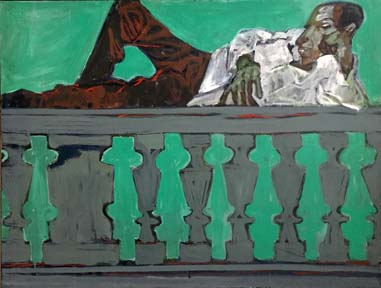
MORTON DIMONDSTEIN
1920-2000
AMERICAN
CLICK ON IMAGES FOR LARGER PHOTOS
"MAN RECLINING ON BALUSTRADE"
OIL ON CANVAS, ESTATE STAMPED
PAINTED IN ITALY
C.1960
28.25 X 38 INCHES
SUBJECT OF THE PAINTING IS MARTIN LUBNER WAS A FRIEND AND PARTNER OF THE ARTIST,
AND IS AN ARTIST IN HIS OWN RIGHT.
SOLD
"MARTIN LUBNER SMOKING"
OIL ON CANVAS, SIGNED
DATED 1968
36 X 30 INCHES
MARTIN LUBNER WAS A FRIEND AND PARTNER OF THE ARTIST,
AND IS AN ARTIST IN HIS OWN RIGHT,
"SELF PORTRAIT OF THE ARTIST SCULPTING IN HIS STUDIO"
OIL ON CANVAS, ESTATE STAMPED
C.1960
31.5 X 29 INCHES
"TRE BAGNANTIS"
OIL ON CANVAS, ESTATE STAMPED
PAINTED IN ITALY
C.1960
40 X 47.6 INCHES
SOLD
"SELF PORTRAIT
OIL ON PANEL, ESTATE STAMPED
C.1950
34.75 X 20.25 INCHES
"AGE AND YOUTH"
OIL ON PANEL, ESTATE STAMPED
C.1955
31.75 X 27.5 INCHES
"GOOD AGINST EVIL"
OIL ON PANEL, SIGNED
DATED 1957
40 X 23.75 INCHES
SOLD
Morton Dimondstein 1920-2000 At the age of seventeen Morton Dimondstein enrolled in the American Artists School and then the Art Students League in New York City, where he studied painting, drawing, and printmaking with Anton Refregier, Harry Sternberg, and Kimon Nicolaides. After serving in the 387th Field Artillery Battalion during World War II, Dimondstein continued his studies at the Otis Art Institute in Los Angeles. He was one of the first artists to produce serigraphic prints on the West Coast, marketing them as affordable art in galleries and retail stores. His prints and oil paintings garnered several awards during this post-war period, including an A.C.A. Gallery international competition for a one- man show in New York City. In 1951 he moved to Mexico, where he attended the Instituto Politécnico Nacional and studied art with José Gutiérrez and David Alfaro Siqueiros. During his three years in Mexico, Dimondstein worked as a staff artist and instructor in visual education for UNESCO and was a member of the Taller de Gráfica Popular. After moving back to Los Angeles, Dimondstein served as the art editor of the California Quarterly from 1953 to 1956. He briefly worked for the Saul Bass advertising firm where he designed books and book jackets, and collaborated on the ad campaigns for films such as William Wyler’s “The Big Country” and Otto Preminger’s “St. Joan.” Dimondstein received industry recognition for the images he created, but cranking out art for commercial ventures with strict deadlines was not for him. He chose to leave that world in favor of working as an independent artist and art teacher. Over the years he taught at the Kann Art Institute, the New School of Art, the University of Southern California in Los Angeles, and the School of Fine Art which he established with UCLA faculty member Martin Lubner. In 1960 there was an exhibition of Dimonsteain and Martin Lubner at the Norton Simon Museum in Pasadena, California. In 1960 Dimondstein and his family moved to Italy. During these Italian years (1960-1964) he began to sculpt, which proved to be a turning point in his career. While continuing to produce works in various print and paint media, Dimondstein devoted himself to developing his new form of expression. Sculpting in wax, he would then cast his nudes, semi-nudes, and allegorical figures in bronze. In the late sixties, Dimondstein began sculpting in wood and in polyester resin. He continued to paint, but no longer on canvas. Instead, he painted life-sized portraits using acrylic on paper with a “sure sense of composition...ability to exploit color as a formal device...and a free spirited feeling for improvisation” (Los Angeles Times, October 18, 1986). Active as an artist until 1998, Dimondstein shunned artifice and gimmickry, never synthetically creating a style or embracing a fad. He took what he regarded as “the more difficult road...permitting my work to be shaped by changing ideas, the materials I use, the accidents of place and displacement....” Critics concurred that he eschewed “changing fads and fashions, evolving instead within the ongoing Modernist figurative tradition” (Los Angeles Times, 1986). The road Dimondstein traveled from early on branched off in many directions, but each path took the same route, toward an art that attained the highest level of craft and workmanship, an art that sought solutions to its intrinsic concerns, and an art that, according to La Vita in 1961, conveyed an appreciation for “the human image...without esthetic excesses... always granting it its own sense of poetry, its rightful dimension, its dignified pathos.” Whether stripped down to its most elemental and biologic forms or embedded in a life sized, richly detailed environment, the human image--and the human condition--was central to Dimondstein’s vision.
|